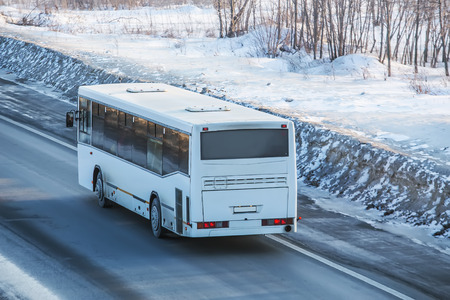 Winter driving can be challenging due to heavy snowfall, strong winds, and freezing temperatures that create slippery road ice. Even after the snow has been cleared and salted, the driving conditions can still be hazardous, so it’s important to take precautions when traveling during winter.
Winter driving can be challenging due to heavy snowfall, strong winds, and freezing temperatures that create slippery road ice. Even after the snow has been cleared and salted, the driving conditions can still be hazardous, so it’s important to take precautions when traveling during winter.
Whether you own or manage a fleet of buses or drive one yourself, it’s important to stay educated on the best safety measures for operating a bus in winter conditions. Keep yourself and your drivers updated with these essential tips for safe winter bus driving!
Refresh Everyone’s Training
Get new drivers ready and remind seasoned professionals of the rules of the road with an overview of winter driving practices before the season is in full swing.
You can use various training resources to cover all the important information—videos, booklets, etc.—and even have experienced drivers share their advice with the group. Set up a practice area where drivers can get used to or reacclimated with winter driving techniques.
Stay Informed About the Weather
As a bus company manager or driver, you should always know the latest road conditions and expected weather for the day. Ensure everyone on your team knows what’s to come so they can plan their routes accordingly and adjust how they drive.
If conditions on the normal route are expected to be dangerous, have alternate routes planned to avoid putting passengers at risk. The speed at which your drivers move and the distance they keep from other people on the road should be modified to account for the severity of the weather.
Inspect Buses Before Heading Out
At the onset of the winter season, all buses in a company or fleet should be thoroughly inspected so necessary repairs can be made before harsh weather hits. For example, if a vehicle’s receiver dryer has not been replaced that year, now is the time. You’ll also want to turn on the defroster and run your hand under the dash to check for air leaks in the heating system.
Replace any dirty HVAC filters with clean ones, so you know your systems will be working efficiently when the temperatures dive. Lastly, check the water valves of your buses’ heaters to ensure they don’t stick after not being used for so long.
Drivers Should Complete a Checklist Before Every Trip
In addition to an annual pre-winter inspection, drivers should examine their buses individually before each excursion to ensure everything is in working order. Have each driver do the following at the beginning of their shift:
- Check that heaters are working
- Confirm the AC is functioning (so the defroster works properly)
- Test windshield wipers
- Check window washer fluid levels
- Store a can of de-icing spray on the bus
- Make sure the headlights are working
- Clear ice and snow from windows, mirrors, and headlights
Always Drive Cautiously
The best tip for any winter driver is to always drive in anticipation of dangerous conditions. Bus drivers especially need to constantly be prudent on the road to prioritize the safety of their passengers. You should always be alert and aware of the traffic and what is happening around you.
Slow driving is essential when snow or ice is possible on the roads. Approach intersections more cautiously and slow down for every turn to avoid losing traction and then control of the vehicle. Drivers should also keep a safe distance between their bus and other motorists and objects on the road in case of sudden stops or unexpected accidents.
The most important thing to remember as you take your bus out on the road this winter is that it’s always better to be safe than sorry. Start by ensuring that you’re driving a top-quality vehicle!
At Northwest Bus Sales, we’re committed to providing a vast inventory of new and used buses in excellent condition, perfect for any season. Call us today at (800)231-7099 to see what our sales lot has in store for you!
